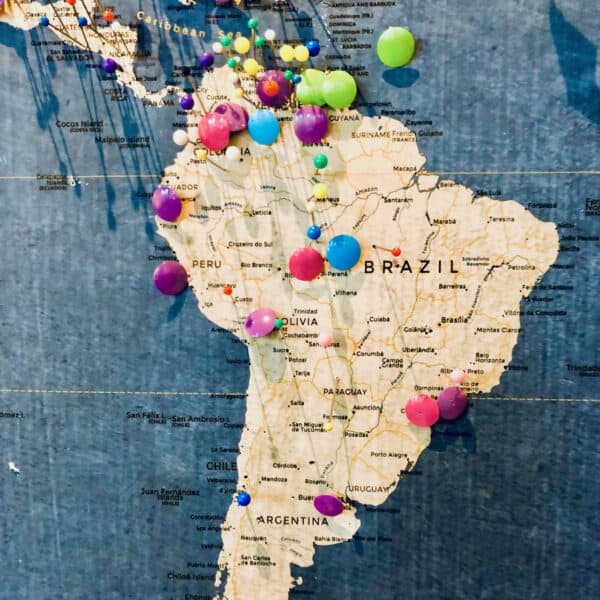
Latin America and the Caribbean has emerged as a red hot region for Fintech development. A portion of the world long dominated by incumbent banks and other established service providers, Fintech has emerged as a fast track path to provide traditional and highly sophisticated services to a largely underbanked or unbanked population.
The Inter-American Development Bank (IDB) has recently published a report that provides unique perspective into the fast-growing Latam Fintech sector along with the status of regulator developments necessary to enable its growth.
The IDB has created an interactive Latin America and Caribbean Fintech Regulation Map that allows a viewer to review the status of various sectors of Fintech in regards to regulation.
Along with its ongoing Fintech LAC section, the IDB has published a report providing an in-depth view of Fintech in Latin America and the Caribbean.
This report states that the number of Fintech platforms has grown rapidly since 2018 jumping from 1166 to 2482 by the end of 2021.
The IDB Fintech report shares:
- 80 % of them are concentrated in Brazil (31%), and Mexico (21%), Colombia (11%), Argentina (11%) and Chile (7%).
- Payments and Remittances account for (23%) and Loans (18%), Enterprise Technologies for Financial Institutions (14%), Enterprise Finance Management (10%) and Personal (7%).
- Investment in Fintech platforms increased significantly to over US$1.6 billion in 2021.
While some incredibly successful Fintechs have emerged in the region, the IDB report notes that there has been an increase in “cross platform collaboration” as traditional finance attempts to keep pace with the speed of change.
CI recently connected with Diego Herrera, Financial Markets Lead Specialist who led the creation of the report. Our discussion on Fintech development in Latin America and the Caribbean is shared below.
What are the largest inhibitors to Fintech adoption in Latin America and the Caribbean?
Diego Herrera: The largest inhibitors to the growth of Fintech in Latin America, according to the results that we share in “Fintech in Latin America: A Consolidated Ecosystem For Recovery“, are the impossibility to scale, the lack of financing for growth, and project launching.
For the first factor, we see the expansion of Fintech platforms across the region to increase the reach for scale. A total of 30% of the Fintech companies that orginate in the region, operate abroad.
For the second aspect, the barriers are slowly disappearing: the Latin American and the Caribbean fintech sector received US$6,093 million in Venture Capital investments in 2021, equivalent to 39% of the total amount of capital invested. The sector continues to consolidate thanks to significant investments and dedicated funds, and the emergence and growth of new ventures.
For the latter, the increasing number and quality of public policies are making it easier for entrepreneurs to launch their products. However, more needs to be done in this front.
Some LatAm Fintechs have experienced incredible growth and rapid adoption. How are traditional financial services firms reacting to the competition?
Diego Herrera: In general, the reaction from the incumbents of the financial sector has been towards coopetition (competition and cooperation) with the Fintech sector. Our study shows how 45% of a universe of more than 650 Fintechs surveyed, 45% are engaged with incumbents through commercial alliances, integrating themselves into the value chain as their suppliers or customers. Part of the reason is the large interactions from payments platforms, who are more than a third of the sector. On the other hand, Fintechs interact with the traditional financial sector through pilots (15%), testing products within the value chain of the latter. A similar situation occurs with some 11% of platforms conducting proofs of concept with incumbents. As has happened in other world regions, the border between entrants and incumbents starts to be dimmer.
Access to capital is key for early-stage/growth stage firms. Are Fintechs playing a role in this in LAC?
 Diego Herrera: Our study references what we found for alternative finance and crowdfunding companies.
Diego Herrera: Our study references what we found for alternative finance and crowdfunding companies.
Last year, we produced the Second Global Alternative Finance Market Benchmarking Report to deconstruct the Alternative Finance (AF) and Crowdfunding Ecosystem in Latin America and the Caribbean (LAC) with the Cambridge Centre for Alternative Finance (CCAF). The results were interesting: the region reached $5.27 billion in originations for 2020, representing a stunning 191% growth compared with 2018.
Most importantly, the LAC AF ecosystem increased the share of business finance to reach 86% in 2020 from 60% in 2018.
In a more recent study that we will publish in the next couple of weeks with CCAF, we show how firms that were able to access Fintech funding could also increase or maintain their number of employees (92% of the total), income (86%), and turnover (84%).
Fintech-financed firms became resilient, even in the middle of a very adverse situation such as the pandemic, thanks to credit availability. The results are even more relevant if it is taken into account that 83% of the firms were micro-enterprises (ten employees or less).
Consequently, it is safe to say that Fintech platforms appear to be a feasible alternative to finance the Micro, Small, and Medium Enterprises (MSME), which are 95% of their client firms.
Overall, are policymakers aiding or impeding Fintech growth?
Diego Herrera: Policymakers are slowly catching up with the sector’s advancements. We have identified seventeen (17) regulations in the region for different segments: crowdfunding and alternative finance (4), fast retail payments systems (5), open finance (2), trading and Robo-advisors (3), and cryptoassets (2). Still, the region needs to advance faster because a more organized sector and clear rules enable investments. The benefits of fintech are evident from the point of view of MSME credit and payments, as Brazil has shown with PIX.
On the other hand, policymakers have been ruling and implementing regulatory innovations that allow for the promotion and development of the Fintech industry.
The most relevant innovations are the innovation hubs and the regulatory sandboxes.
In particular, we have seen the rise of eight (8) innovation hubs in the region as a tool to create dialogue and knowledge between innovators and regulators. Inter-American Development Bank has supported such initiatives in four countries in the region. Three have implemented innovation hubs: Costa Rica, Dominican Republic, and El Salvador.
On the other hand, Brazil, Colombia, and Mexico have implemented regulatory sandboxes, with diverse outcomes, in testing innovations for the financial sector.
The results for the regulations in the region are shown in the study and in FintechRegMap, an interactive map showing the status of relevant fintech regulations in LAC. The study also includes visuals for regulatory sandboxes and innovation hubs in the region. The map is available at www.iadb.org/FintechRegMap.
Financial inclusion is a key theme in North America. Sophisticated services, once only available to a small segment of the population, are now extremely accessible in many regions. Will this fuel collateral development and entrepreneurship in Latin America and the Caribbean?
Diego Herrera: Fintech is no longer a phenomenon or a novelty, and has become a reality with impacts on the lives of citizens of Latin America and the Caribbean through greater financial inclusion.
Examples abound in the region, starting with adopting fintech platforms and central bank systems that allow their participation in making payments and transfers. Likewise, another example of adoption is the use of crowdfunding platforms to finance micro, small, and medium-sized companies, taking advantage of public policies that enable factoring.
Finally, the appearance of actors such as platforms that offer application programming interfaces -APIs- or blockchain-based infrastructures that promise to change business models to improve financial inclusion in our region are crucial to widen the scope of Fintech.
In a summary, the incentives are aligned and we expect more entrepreneurship and the development of collateral alternatives such as cryptocurrencies via DeFi.
Are Fintechs based outside LAC (Like NA or EU) playing a significant role?
Diego Herrera: Not yet, but as the market grows, we expect to see more and more participants from other jurisdictions.
There is one large exception: cryptoassets. We are currently working with CCAF in writing a report on the cryptoassets ecosystem in Latin America and the Caribbean. We have found several global players offering services in the region.

